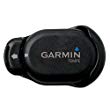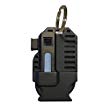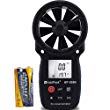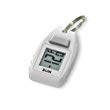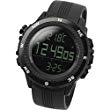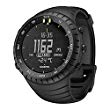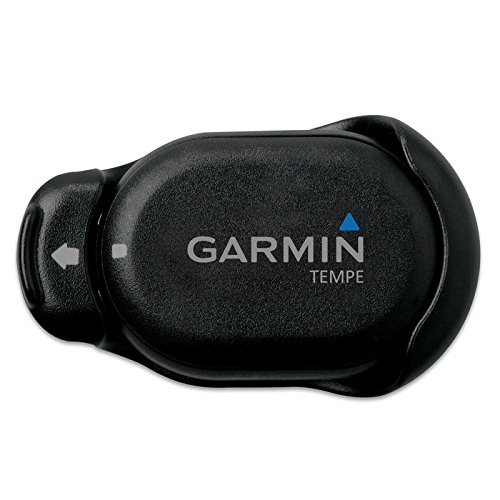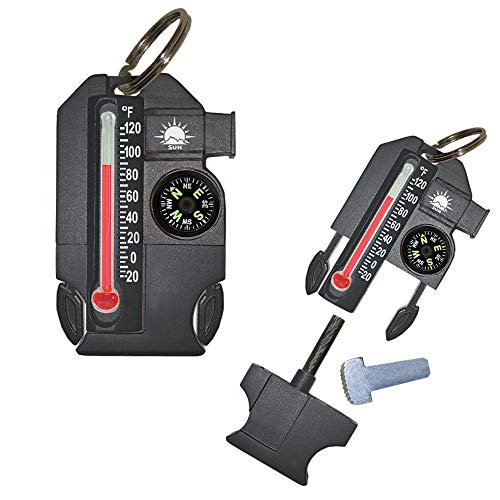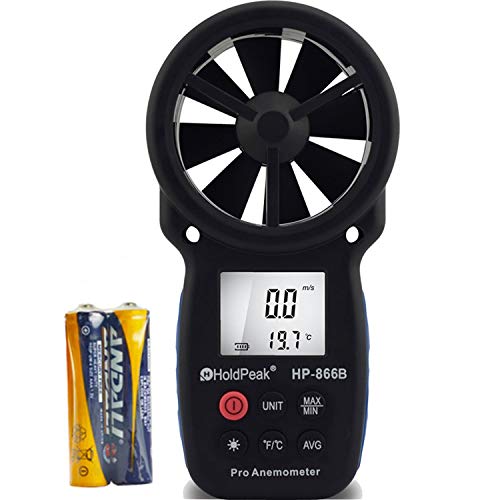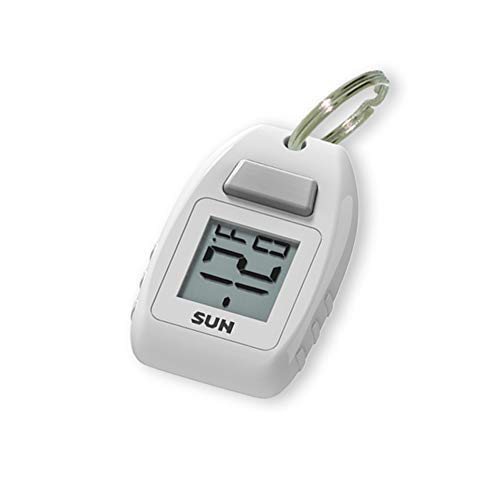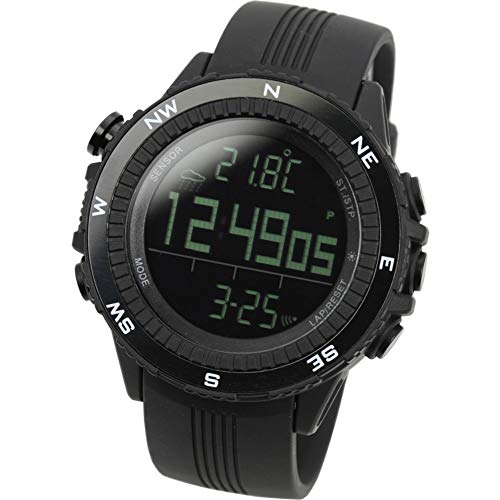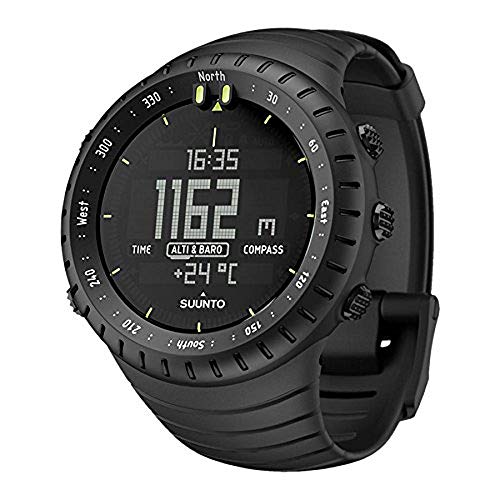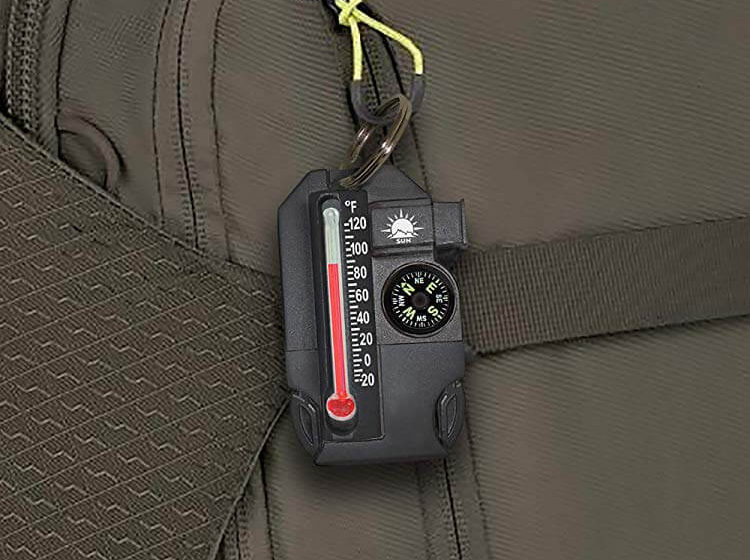
Whether you’re carrying a thermometer for research, personal data collection, or safety there has never been a better time to find one that works for you!
More...
I remember getting my first outdoor watch. It was an off-brand because I couldn’t afford much at the time. Don’t be fooled though, I was happy as a lark to have a digital compass, barometer, and thermometer on my wrist!
These days I’ve hit the trail with high tech gadgets, GPS units, smartwatches, and no gadgets at all during certain times. Every backpacker and every trip calls for a different approach to finding the right technology to wear and carry for the ideal trip. In today’s article, we’re going to focus specifically on thermometers for the trail.
Comparison Chart
Name | Price | Weight | Rating | Notes |
|---|---|---|---|---|
$$$ | 2.88 oz | Outdoor watch.Transmit ambient temperature data wirelessly to your device with the tempe external wireless temperature sensor | ||
$$$ | 0.96 oz | CUSHION MOUNTED THERMOMETER - Reads down to a chilly -20 degrees Fahrenheit | ||
$$$ | 7 oz | MULTIFUNCTIONAL ANEMOMETER YOU WILL NEED: Wind Speed, temperature and wind chill in one LCD display. | ||
$$$ | 0.64 oz | OPERATES IN SUPER-COLD TEMPERATURES - The battery and LCD in Digital Zipogage were engineered to operate in temperatures as low as -20° Fahrenheit (-30° Celsius). | ||
$$$ | 5.6 oz | Function: Altimeter, Barometer, Compass, Thermometer, Weather forecast, Stopwatch, Timer, Alarm, Water resistant 3 ATM | ||
$$$ | 4.8 oz | Suunto core tracks both the weather and the sun for you; Operating temperature: -20° C to +60° C / -5° F to +140° F |
Why Use a Backpacking Thermometer?
Understanding the Limitations of a Thermometer
Thermometers are what’s called a lagging indicator. That means that the weather has already begun to trend in the direction that the thermometer is showing by the time the thermometer shows it.
What that means is that a thermometer can’t predict the upcoming temperature it can only show you what has already happened. A leading indicator would be something like weather radar showing two converging weather fronts which, several hours from now, will likely cause a temperature drop.
Thermometers can show you what the temperature is right now but they can’t show you what it will be in 10 minutes, an hour, or a day from now.
This shortcoming leads to inherent restrictions on the usefulness of a thermometer as a hiking aid for weather prediction. Once you’re on the trail, you’re stuck with what you brought. Knowing that it’s getting colder or warmer isn’t going to help you gain or lose clothing from your pack.
Many hikers are in the “if it’s going to rain, it’s going to rain” camp of weather prediction attitude.
Basically, this school of thought says, regardless of how many weather-predicting watches, smartphones, or thermometers you take into the field the weather is going to do its own thing and there’s nothing you can do about it, so why bother?
This school of thought might go like this: If it feels cold enough to freeze your water bottle, you better put it in the foot of your sleeping bag to be safe. It doesn’t really make a difference if the temperature is 32 degrees or 13 degrees, the result (and your behavior) is the same. Besides, you have no way of knowing if the temp will continue dropping or warm up, so why bother staying awake and staring at your thermometer?
In the opposite corner are the people who just need to know what the temperature is. Maybe you’re recording the weather each day in a journal, a logbook, or just checking in before you take off in the morning to see what the mercury says. For some, it brings peace of mind and reliability.
Who knows whether it will rain, warm up, or cool down. If you just need to know what the temperature is right now then a backpacking thermometer is right for you.
Combining a Thermometer With Other Predictive Tools
For meteorologically-inclined hobbyists and experts, a 12 or 24-hour historical chart of real temperatures can be a predictive tool to some degree. Unfortunately, to be anything more than a guess you’d also need to understand weather patterns, cloud types, and ideally chart other factors like barometer readings. Most of us cannot do this so there is limited applicability for this type of prediction on the trail.
However, when you combine a thermometer with a digital barometer on a watch that has pre-programmed predictive abilities all of a sudden it becomes quite useful.
Today’s backpacking watches have ever-improving thermometers and barometers which are becoming increasingly intelligent and predictive. When you put a thermometer in combination with something like this it suddenly can help any hiker predict upcoming weather with improved accuracy.
For doing anything other than simply recording current temperature values, combining a thermometer with other predictive tools is a necessity.
How to Choose a Backpacking Thermometer
Where do you want your thermometer to live?
No, not which city or continent. I mean, where on your person do you want your thermometer to be located by default?
Backpacking thermometers come in many shapes, sizes, and styles. Which one you choose should be partially based on where you want to carry it.
Backpacking thermometers carried on the pack, hip belt, or shoulder strap are totally acceptable. In fact, you can just clip a small conventional thermometer to your pack and be all set! It’s cheap, simple, and effective. However, it’s hard to see the thermometer at a glance when clipped to most locations.
Another option is to carry a wrist-mounted thermometer such as those found on watches. Of course, this style is quite accessible but it does come with a few downfalls. It’s a great choice if you need to reference the current temperature often, however.
One of the biggest drawbacks to worn thermometers, such as those found on outdoor watches, is that they are almost invariably affected by body heat. If you have a glove or jacket over the watch, it won’t read anywhere near the true ambient temperature. Just the radiant body heat from your wrist warming up the watch housing is enough to throw off the reading by a significant margin.
Hanging a thermometer from the tent, inside or outside, is a good way to keep an eye on overnight ambient temperatures. The viability of this method is limited, however, to simply showing you a snapshot of the current overnight temperature which is arguably marginally useful in most cases.
Each thermometer location and style has pros and cons, you’ll have to consider which style is right for your needs.
What is your budget?
If you have a low budget then your best bet is the old analog “mercury” thermometer. These can easily be found on keychains in small sizes and are very lightweight (less than an ounce). That makes them a solid winner in my mind.
If you’re not happy with the classics and you’ve got some benjamins burning a hole in your pocket, it might be time to think about digitizing. Modern wrist-computers (outdoor watches) can do everything from updating you about politics when you’re on your favorite mountain to giving you a real-time picture of the ambient environmental temperature. Get ready for the $300 – $900 price tag though and expect that price tag to keep climbing over the years!
Do you need predictive capabilities?
If you want a forward-looking picture of weather by using your thermometer then you’re going to have to cough up those benjies. Outdoor watches with barometers, altimeters, and thermometers all rolled into one synchronized package are about the only thing capable of reasonably predicting incoming weather without access to a full NOAA radar station.
Happy just checking on the current temperature? Then an analog “mercury” style thermometer will do you just fine and save you a ton of cash!
Can you save money by combining functions?
Okay, an outdoor watch with a thermometer is expensive. However, the more affordable ones aren’t altogether ridiculously priced for the average consumer.
What if we save money by combining outdoor gear? Instead of carrying a handheld GPS, a phone, and a thermometer maybe you could get away with just using a smartwatch with all of those capabilities rolled into one!
By the time you figure the cost of a standalone GPS unit and a thermometer-enable watch separately you might just save money by ditching the handheld GPS ($90 – $400) and instead buy a reasonable smartwatch with GPS and thermometer abilities. You’ll have one device instead of two, less to charge, less weight, and less money out the door in some cases.
So, instead of buying an “okay” smartwatch and an “okay” hiking GPS maybe you’d be better off just laying out some big bucks for a good outdoor watch with everything you want in one package? Just a thought.
How much weight are you willing to carry?
Backpacking thermometers range from lightweight key fobs to heavy handheld wind-monitoring devices.
If you just have to know the temperature inside your tent versus outside your tent and you need a device that can save and upload all that data to your home computer after your hike, well… As you can imagine such a device will be a bit heavier, bulkier, and more pricey than a simple “mercury” style keyfob thermometer.
If you’re an ultralight purist then your weight tolerance is probably bare minimal and, as an ultralight guy myself, I’d be surprised to see many ultralight hikers carrying thermometers at all.
For hobbyist with a strong interest in environmental data, personal data, or research then the weight of more advanced backpacking thermometers is probably substantially more justified.
Similar to saving money by combining functions, you might be able to save weight by combining functions. For instance, if you can carry a smartwatch that can replace your thermometer, GPS, and phone you’re pretty likely to actually carry less weight by taking a thermometer-enabled outdoor watch than the alternative in this example situation.
Consider the tradeoff between weight and function before buying.
Best Backpacking Thermometers
By far the most accurate, helpful, and capable backpacking thermometer on the market right now is the Garmin Tempe. Note that this thermometer requires the Garmin Fenix backpacking watch (or similar compatible Garmin device) to work.
It’s a little difficult to get an apples-to-apples comparison of this thermometer because in combining the Tempe and Fenix watch you can effectively replace or eliminate several other pieces of gear (such as a standalone GPS).
Once it’s paired what you get is accurate temperature data that can be used alongside your Garmin smart device to track and record or even help predict upcoming weather.
Maybe the best overall feature of the Tempe is that it allows the Fenix smartwatch to gather accurate temperature data. Unlike watches with built-in thermometers, this remote thermometer can be clipped to your pack or tent where your ambient body temperature won’t throw off the reading.
Note: Keep the unit out of direct sunlight when in use or the warming from the sun will surely throw off the accuracy of the temperature reading. Consider tucking it into an outside pocket on your pack.
Some users complain that the device takes a while to connect. Additionally, there are no status lights or LEDs to show you if it’s working, low on battery, or otherwise operational and many consider this a downfall.
At just over 1 ounce this little thermometer serves quadruple duty in your pack. On top of the analog thermometer (at a very affordable price I must say) there are several backup survival tools in this little package.
On the front is a traditional “mercury” thermometer. Due to the size and quality, however, I wonder about the pinpoint accuracy of the thermometer. That said, it should be accurate enough for all but scientific expeditions and the average user is likely to find it satisfactory.
Additionally, there is a small 2-axis compass and whistle at the ready. This is a handy combo to have clipped to your sternum strap for survival situations should you find yourself in one.
Note: This small compass is likely to be anything but high-performance. While it’s definitely not an orienteering compass, it’s better than nothing in a pinch…
Inside the thermometer housing is a (small) ferro rod and striker for emergency fire starting.
All said and done it’s a very affordable lightweight and small thermometer with several emergency features that could always be handy to have around.
If you’re looking to take things up a step, a mini anemometer will provide some data that other instruments just can’t.
While expensive smart tech can really dial in readings with an altimeter, barometer, and thermometer they’re still missing one key. Wind speed is absolutely necessary if you’re going to try to calculate wind chill – a huge factor in mountaineering and backpacking.
This anemometer, or wind speed instrument, has a single rigid housing which contains the digital display and the fan blades which pick up the wind speed data. The fan blades are well protected compared to some other models so it’s a bit more likely to survive the rigors of the trail and storage inside your pack.
Not only will you get an accurate wind speed reading, but the digital LCD display will also automatically calculate and display the temperature and wind chill all at once.
This is probably a tool best-suited for cold weather conditions or alpine mountaineering. Simultaneously, however, this is a bulky and heavy instrument to carry on the trail so it probably only belongs in the packs of those who truly need to know the wind chill at all times.
At just about half an ounce, this zipper-pull digital thermometer is meant to be kept on you at all times to quickly check the weather.
There’s a single push-button on the unit which quickly pulls up an accurate digital reading of the current temperature all the way down to -20 F. With the included split-ring you can easily attach it to your coat zipper, backpack zipper, or any clip on a harness.
Keep in mind that you want to keep the unit away from other heat sources such as body heat or direct sunlight or it will throw off your readings.
This thermometer is so lightweight and easy to use that I think a wide range of hikers and backpackers could find a versatile use for it on (or in) their pack.
Sure, it might not be the name brand you were expecting, but the price is certainly right! For well under $100 you can get set up with this digital weather-predicting watch that will save you tons of dough compared to leading names.
By combining the onboard thermometer, barometer, and altimeter this watch can predict upcoming weather trends. You’ll see a little icon on the watch indicating sunny, partly cloudy, cloudy, or rainy.
These weather predictions are entirely based on the onboard instruments so be sure to calibrate the watch before each hike.
While there are a handful of watch colors to choose from, one of the coolest features is the positive/negative display interface. You can select a model with a black background and white numbers or white background with black numbers (standard).
At the end of the day, the entire watch weighs just barely 2 ounces and it makes for a very powerful and affordable hiking tool!
I think we’d be remiss to cover backpacking thermometers without mentioning the Suunto Core. This long-standing leader in wearable outdoor instruments has been wildly popular for years among the military, mountaineers, and backpackers.
It’s going to cost you a bit more than some other off-brands but I know a lot of us would rather pay a little extra for a reliable and trusted brand.
Onboard is a thermometer, barometer, and altimeter. Taken together the watch is able to compile a digital weather trend graph and automatically alerts you to potential incoming storms with an audible alarm.
Unlike some other cheaper watches, the Suunto Core also packs in an accurate and reliable 2-axis compass. For serious backpacks and mountaineers, there are few other watches out there that can keep up at this price range.
FAQs
How accurate are the onboard sensors on outdoor watches?
What are the best uses for a thermometer on a hike?
Is mercury still used in thermometers?
Conclusion
My goal was to first illustrate what hiking thermometers are, how they can be used, and their limitations. Now that you’re thinking about how a thermometer might (or might not) help you on the trail you’re ready to start looking for one to buy.
In the reviews section of today’s article, I’ve lined up some of the highest and lowest-tech thermometers you’ll find. Whether your budget is $5 or $200 there is a backpacking thermometer on our list for you.
Remember that each person has a different ideal thermometer. If you’re a climber you might want a thermometer on your watch. If you’re gathering data for a daily logbook, you might want a standalone thermometer with a wind speed sensor.
After reading our article you should be ready to make a decision, so visit the reviews and get started shopping so you can spend more time on the trail and less time trying to make a decision!

